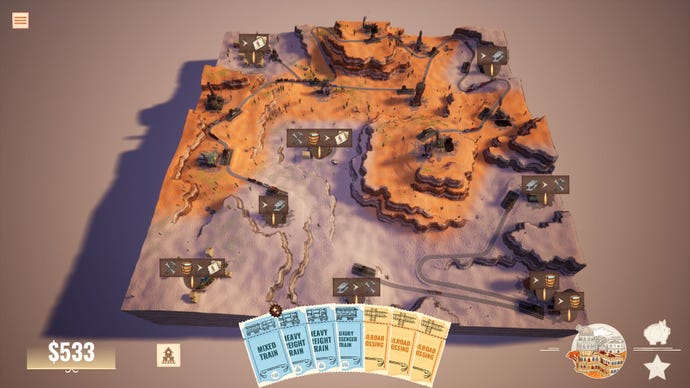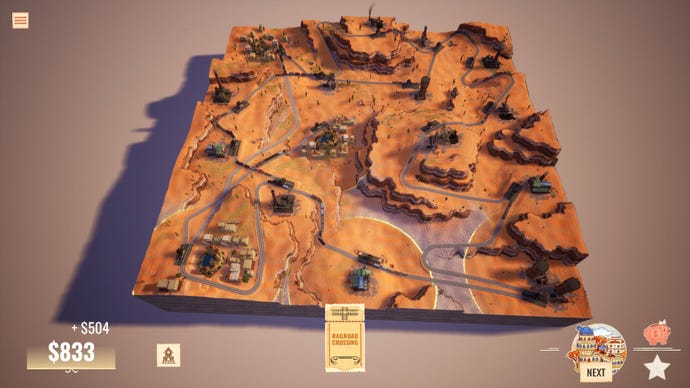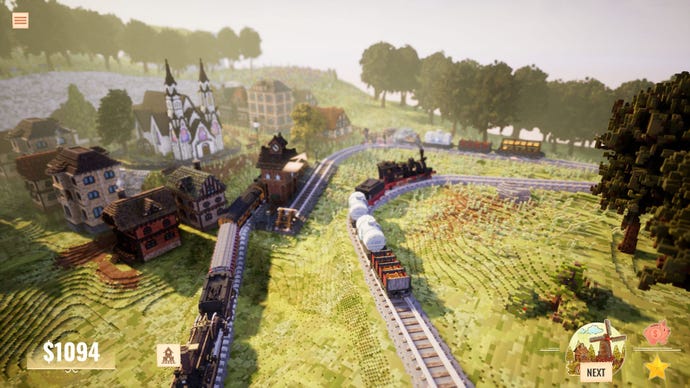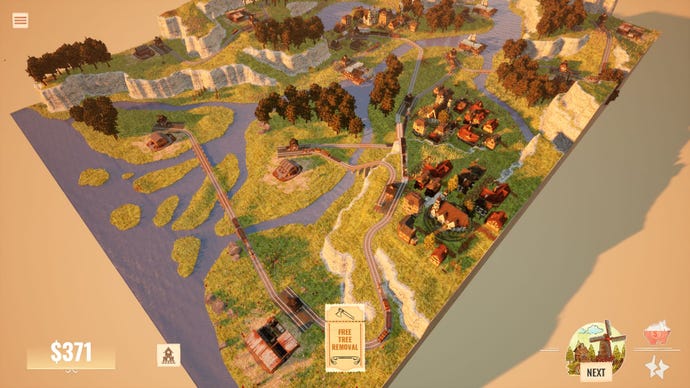I think basically everyone loves trains, even if you’re not chasing royal people with a camera strapped to your big fancy nose. Because trains are a big magical means of people transportation that can zip around the country. And not just people! Trains carry cargo, as depicted in the beautiful voxel maps of the puzzle game Station To Station. Cheese, furniture, steel frames – everything a growing city needs. As the UK government is quick to say, laying the rails that connect all production chains is often a complex task. But if you do it right with Station To Station, you’ll reap the benefits of an already beautiful game becoming even more beautiful.
Station To Station is divided into different stages, these are like different biomes with a train-like feel, and you advance to the next stage once you complete enough levels in the previous stage. There are European-style grasslands with rivers and large interrail atmospheres, orange wastelands with cities built around oases, and tricky mountains. They all have pre-placed production points that need to be connected to iron webs, and they are all usually connected to cities that are squatting in different corners of the map like large, increasingly fat spiders. Masu.


This is because each level is also divided into stages. You might have a dairy and cheese factory on the opposite side of the map, a grain farm and flour mill in the third corner, and a city in the middle. Therefore, each supply chain must connect all the necessary routes until it is “completed”. Buildings emit golden halos of light, bringing your map to gorgeous voxel-like life, populating your map with horses, and planting leaves on your trees. However, all required networks must be linked. The factory must be connected to the bakery. Otherwise, it will not serve its purpose. Nor can he connect one flour mill to two bakeries. A flour mill produces 1 unit of flour for making bread. The second miller has to send the flour to his second bakery in a new truck. What’s more, you have to receive grain from another farm.
However, each time you complete a substage of the map, a new building on the map must be destroyed and integrated with the railway network. The puzzle-like bits (which can be omitted in a sort of free-play mode) are enforced by a) the fact that stations and tracks cannot be moved once laid, and b) money. You receive a starting amount of a few hundred coins to place the starting network in Gaiaband, but the ill-advised placement of stations in the first stage of the level means you need to connect the mines in the third stage. Therefore, you will feel the pinch immediately. Either take a very long road or take an expensive bridge down the valley wall. Each time you complete a supply chain, you get more money, but if you complete multiple supply chains in one truck, you get even more money.



So the point is: do you want to spend more money now, lining up six tracks with no immediate revenue in the hopes that you’ll have the money to complete your grand plans later, or play it safe? or build your own project. He loads the network one shipment of bread at a time. Station To Station strikes a balance by also providing playable cards in each stage. Perhaps if you run a heavy freight train at the right time, you could double your yield and make a huge profit. Playing cheap bridge cards allows you to shorten valley wall connections and save space.
It’s a lot like how I imagine running a steam engine: a delicately balanced machine that relies on planning, but also a ferocious feat of brute force. The map is planned in such a way that you get into a corner and need to get out of it again. Placing a station with four connectable points at an unfavorable approach angle relative to another station can be costly in the long run. At the same time, Galaxy Grove gives you everything you need to succeed and inspires you to be more efficient. Each level has an optional budget goal and optional bonus goals such as maintaining the maximum number of bridges or finding and clicking on a large number of camels.
It’s really nice just to look at it. Zoom in and you’ll see loaded trains passing by and horses galloping along the completed tracks. It’s a bit like going to a model train, except you build it yourself. You want to build a beautiful railway. Instead of destroying mountain passes with steep bridges, we want to build luxury passenger trains that wind through them. You want your amazing designs to become part of your landscape. There are levels in the forest where you are rewarded for not destroying trees (and each tree destroyed in a forest stage costs money). Station To Station is a short but beautiful puzzle game with a perfect balance that forces you to play in pursuit of a more beautiful engine.
This review is based on a review copy of the game provided by the publisher.
